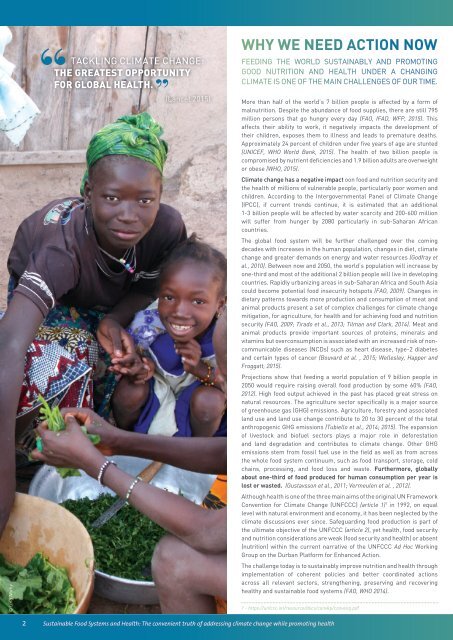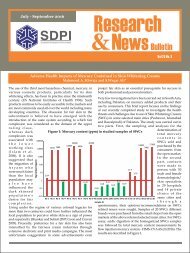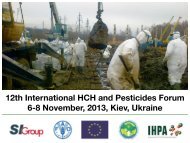SUSTAINABLE FOOD SYSTEMS AND HEALTH
EXE_2_Sustainable_Food_systems_and_health
EXE_2_Sustainable_Food_systems_and_health
You also want an ePaper? Increase the reach of your titles
YUMPU automatically turns print PDFs into web optimized ePapers that Google loves.
© Lina Mahy<br />
© Javier von der Pahlen<br />
TACKLING CLIMATE CHANGE:<br />
THE GREATEST OPPORTUNITY<br />
FOR GLOBAL <strong>HEALTH</strong>.<br />
(Lancet 2015)<br />
WHY WE NEED ACTION NOW<br />
FEEDING THE WORLD SUSTAINABLY <strong>AND</strong> PROMOTING<br />
GOOD NUTRITION <strong>AND</strong> <strong>HEALTH</strong> UNDER A CHANGING<br />
CLIMATE IS ONE OF THE MAIN CHALLENGES OF OUR TIME.<br />
More than half of the world’s 7 billion people is affected by a form of<br />
malnutrition. Despite the abundance of food supplies, there are still 795<br />
million persons that go hungry every day (FAO, IFAD, WFP, 2015). This<br />
affects their ability to work, it negatively impacts the development of<br />
their children, exposes them to illness and leads to premature deaths.<br />
Approximately 24 percent of children under five years of age are stunted<br />
(UNICEF, WHO World Bank, 2015). The health of two billion people is<br />
compromised by nutrient deficiencies and 1.9 billion adults are overweight<br />
or obese (WHO, 2015).<br />
Climate change has a negative impact oon food and nutrition security and<br />
the health of millions of vulnerable people, particularly poor women and<br />
children. According to the Intergovernmental Panel of Climate Change<br />
(IPCC), if current trends continue, it is estimated that an additional<br />
1-3 billion people will be affected by water scarcity and 200-600 million<br />
will suffer from hunger by 2080 particularly in sub-Saharan African<br />
countries.<br />
The global food system will be further challenged over the coming<br />
decades with increases in the human population, changes in diet, climate<br />
change and greater demands on energy and water resources (Godfray et<br />
al., 2010). Between now and 2050, the world’s population will increase by<br />
one-third and most of the additional 2 billion people will live in developing<br />
countries. Rapidly urbanizing areas in sub-Saharan Africa and South Asia<br />
could become potential food insecurity hotspots (FAO, 2009). Changes in<br />
dietary patterns towards more production and consumption of meat and<br />
animal products present a set of complex challenges for climate change<br />
mitigation, for agriculture, for health and for achieving food and nutrition<br />
security (FAO, 2009; Tirado et al., 2013; Tilman and Clark, 2014). Meat and<br />
animal products provide important sources of proteins, minerals and<br />
vitamins but overconsumption is associated with an increased risk of noncommunicable<br />
diseases (NCDs) such as heart disease, type-2 diabetes<br />
and certain types of cancer (Bouvard et al. , 2015; Wellesley, Happer and<br />
Froggatt, 2015).<br />
Projections show that feeding a world population of 9 billion people in<br />
2050 would require raising overall food production by some 60% (FAO,<br />
2012). High food output achieved in the past has placed great stress on<br />
natural resources. The agriculture sector specifically is a major source<br />
of greenhouse gas (GHG) emissions. Agriculture, forestry and associated<br />
land use and land use change contribute to 20 to 30 percent of the total<br />
anthropogenic GHG emissions (Tubiello et al., 2014; 2015). The expansion<br />
of livestock and biofuel sectors plays a major role in deforestation<br />
and land degradation and contributes to climate change. Other GHG<br />
emissions stem from fossil fuel use in the field as well as from across<br />
the whole food system continuum, such as food transport, storage, cold<br />
chains, processing, and food loss and waste. Furthermore, globally<br />
about one-third of food produced for human consumption per year is<br />
lost or wasted. (Gustavsson et al., 2011; Vermeulen et al. , 2012).<br />
Although health is one of the three main aims of the original UN Framework<br />
Convention for Climate Change (UNFCCC) (article 1) 1 in 1992, on equal<br />
level with natural environment and economy, it has been neglected by the<br />
climate discussions ever since. Safeguarding food production is part of<br />
the ultimate objective of the UNFCCC (article 2), yet health, food security<br />
and nutrition considerations are weak (food security and health) or absent<br />
(nutrition) within the current narrative of the UNFCCC Ad Hoc Working<br />
Group on the Durban Platform for Enhanced Action.<br />
The challenge today is to sustainably improve nutrition and health through<br />
implementation of coherent policies and better coordinated actions<br />
across all relevant sectors, strengthening, preserving and recovering<br />
healthy and sustainable food systems (FAO, WHO 2014).<br />
1 - https://unfccc.int/resource/docs/convkp/conveng.pdf<br />
2<br />
Sustainable Food Systems and Health: The convenient truth of addressing climate change while promoting health







